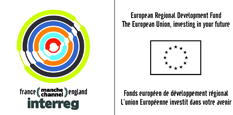INTERREG (inter-regional) is an EU-funded programme that helps Europe’s regions form partnerships to work together on common projects. By sharing knowledge and experience, these partnerships enable the regions involved to develop new solutions to economic, social and environmental challenges.
Flax and its siblings (linen, jute, and hemp) is one of the first fiber families used by man and is evidenced by artifacts found in ancient sites around the globe. Flax is a native to certain latitudes of the earth and thrives particularly well and sustainably in the UK, Europe and points east and west of those countries. Flax has been of particular economic importance through the centuries for its versatility in strength; variety of quality; application for buildings, fabrics, materials, medical applications and food. It comes in a range of natural colours, takes dyes well and can be made into a myriad of materials and products. Its environmental credentials are impressive.The main aim of this project is to increase the production value of flax through exploring its potential use:
Areas of research agreed to date include investigation into the use of flax and flax-based composites as packaging materials, as biomedical materials for wound and patient care, as tissue scaffolds for regenerative medicine and as a food source for healthy diet. The research proposed in this project and the products to be developed are highly innovative and expected to outperform existing products available in the market. In parallel with this aim, the project teams will look at innovative ways in which to minimise waste production and reduce carbon footprint in the production of flax-based products, which implies that the raw and end materials (fibres, seeds, as well as seed mucilages and natural flax composite) are free of any chemical additive and/or are not submitted to any chemical treatment.
The project is led by the University of Brighton in the South of England where the Principle Investigator is Professor Sergey Mikhalovsky from PABS (School of Pharmacy and Biomolecular Sciences) in collaboration with design researchers from SAD (Faculty of Arts' School of Architecture and Design). The research brings together R&D activities of two regional universities in Northern France (Rouen and LeHavre), a research institution (LBN) and a local company with complementary expertise in producing and processing flax fibre and flax composite materials, extracting natural products with medical and nutritious value, manufacturing, characterisation and testing of fibre-based and composite-based carrier packaging and food packaging and biomedical materials.
Flax fibre is an attractive material for a number of reasons: it is mechanically strong, biodegradable and produced from a renewable resource. Flax has high content of poly-unsaturated fats, which are beneficial for health; regular use of such natural substances in a diet reduces level of cholesterol in blood and risk of coronary artery disease. At present applications of flax are fairly limited, mostly because alternative natural fibres such as cotton, silk and jute, imported from overseas, and synthetic fibres are used. Flax fibre accounts for only 0.7% of the world’s fibre production. However, concerns for environmental pollution and global climate change have imposed significant pressure on industry and society as a whole to reduce environmental impact of human activity, in particular, carbon footprint and minimise waste generation in all types of activities, including production and use of materials. It is expected that the use of advanced composite materials based on locally grown flax will make a substantial contribution towards solving this problem.
